At the Hinglaj Resort, Gandhi Sagar, my room was overlooking the magnificent Chambal River.
Waking up every morning to the greenish blue riverscape and the whispering breeze, I felt free.
The openness of the water had a strange fragrance which seeped inside me, leaving behind a deep sense of bonding.
It was my last day at Gandhi Sagar and I had promised myself to be at Yashodharman Boat Club, to discover more.
The previous evening, I had dropped by the Boat Club on my way back from Gandhi Sagar Dam.
As it was nearing sunset, I decided to hop into the last speed boat which was about to leave with a couple of other guests.
I had an inkling of what a speed boat ride could be, however, I did not expect a roller coaster ride!
The boat tossed over the waves, swerved and swayed and went thudding against the water, again and again.
I heard the shrills and the screams of others on the boat, and to my surprise, I found them screaming in joy.
Holding the railing very tightly, I pitifully looked at Captain and he nonchalantly said, “It’s the wind, Madam, please relax.”
While the beautiful twilight was casting a gentle spell over the river, my heart was still settling down from the eventful ride.
Before leaving the Boat Club, I asked Captain about the River Safari that was mentioned on the board next to the Ticket counter.
He said, “Take my word, you will be amazed with the natural offerings of Chambal River. You will have a story to tell. Please come early as it is a 45 minute trip.” I believed him.
YASHODHARMAN BOAT CLUB
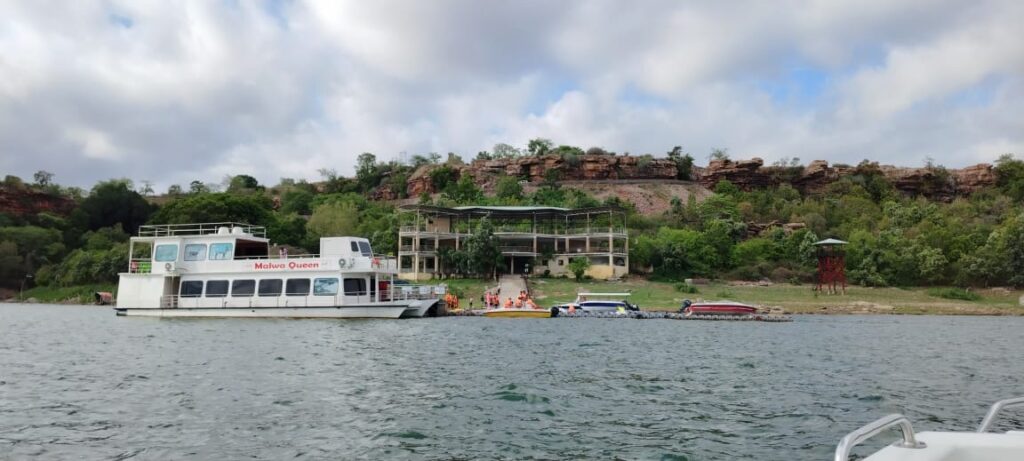
It was around 4 pm. And I was back again at Yashodharman Boat Club. Captain was right there and I walked up to greet him. I had not overcome my timidity yet, and Caption boldly announced “The speed boat that will take you for the River Safari will arrive in a few minutes.”
“Speed boat again?” I murmured. “Yes, he said assertively, “it is difficult for bigger boats to navigate through the canals and get close to the various points. Don’t worry about the bumps, this side of the river is closed on 3 fronts, and the wind force gets controlled, so it will be calmer, and not like yesterday.”
With that note of affirmation, he handed me over to Jagannath and added that he was one of his best boys.
Here again, I met Rajesh Maida, Resort Manager, Hinglaj Resort. He has scheduled rounds at the Boat club every evening as both the Resort and Boat Club are managed by Madhya Pradesh Tourism.
He obliged once again and joined me on the River Safari.
We walked down the ramp and reached the floating jetty.
Jagannath handed over the life jackets and we got into the boat.
As we drifted away from the Club, I spoke to Jagannath about my gnarly ride the previous evening and requested him to wade slowly. He had a warm demeanor and promised to make the trip comfortable and memorable.
CHAMBAL RIVER SAFARI
Chambal River’s rich bio diversity provides habitat for a wide spectrum of animals like leopards and striped hyenas, wolves and jackals, spotted deers and nilgai, amphibians and reptiles, over 200 variety of migratory and non migratory birds and the largest species of fish.
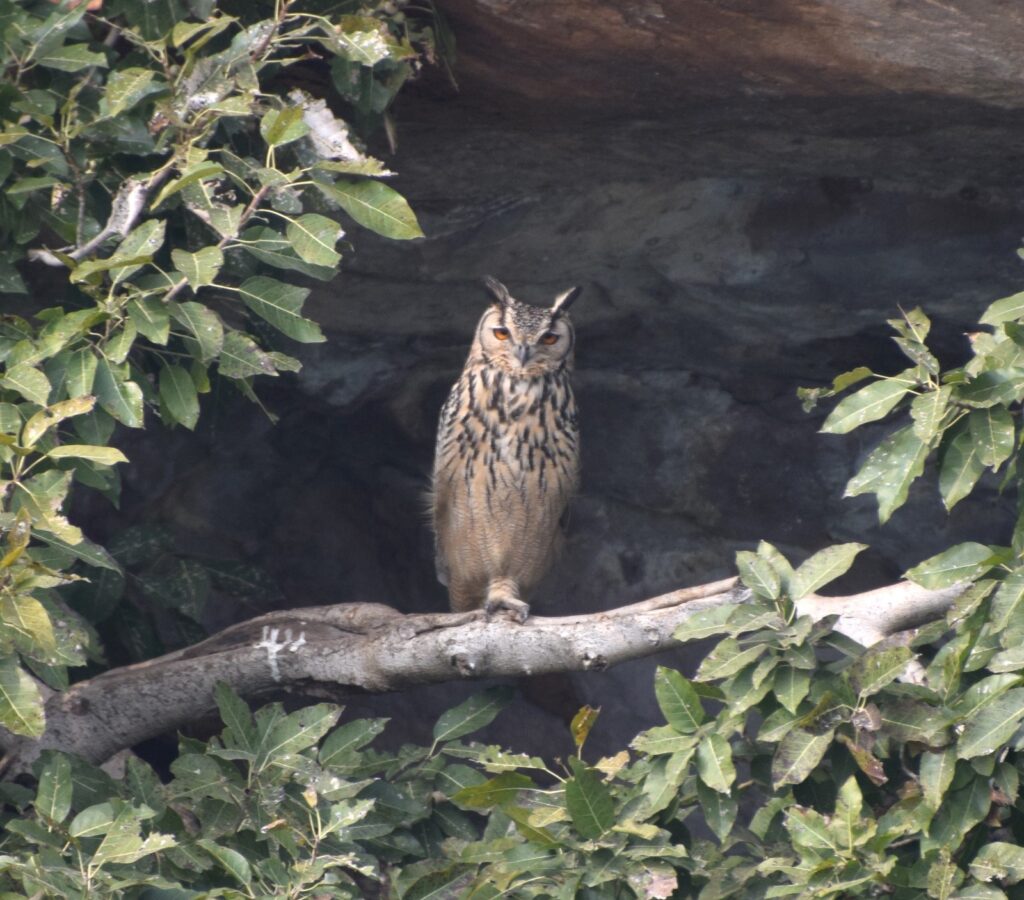
Just out of curiosity, I asked Jagannath about the depth of the river at various points that we would be covering during the Safari.
He explained, “Very deep, around the floating jetty, it is about 40-50 feet deep and as we move further, it is over 100-120 ft deep and near the dam, it goes over 150 ft.”
ROCK FORMATION
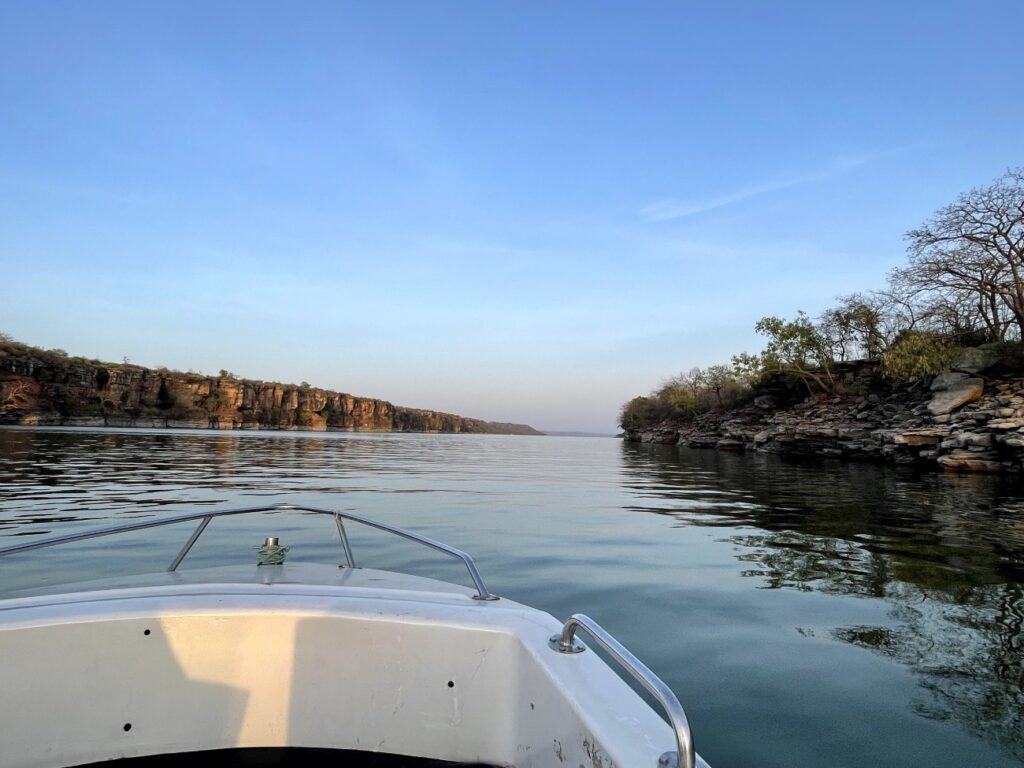
Skillfully, he diverted my attention to the dramatic rock formations on both sides of the river which had breathtaking landscapes.
WATERFALL POINT
As we neared the first point, Jagannath showed us the WATERFALL Point. “This is most scenic spot during rains, with water flowing gorgeously into the river. There is a long queue of tourists to see this Waterfall in the monsoon.” he added.
BIG ROCK POINT
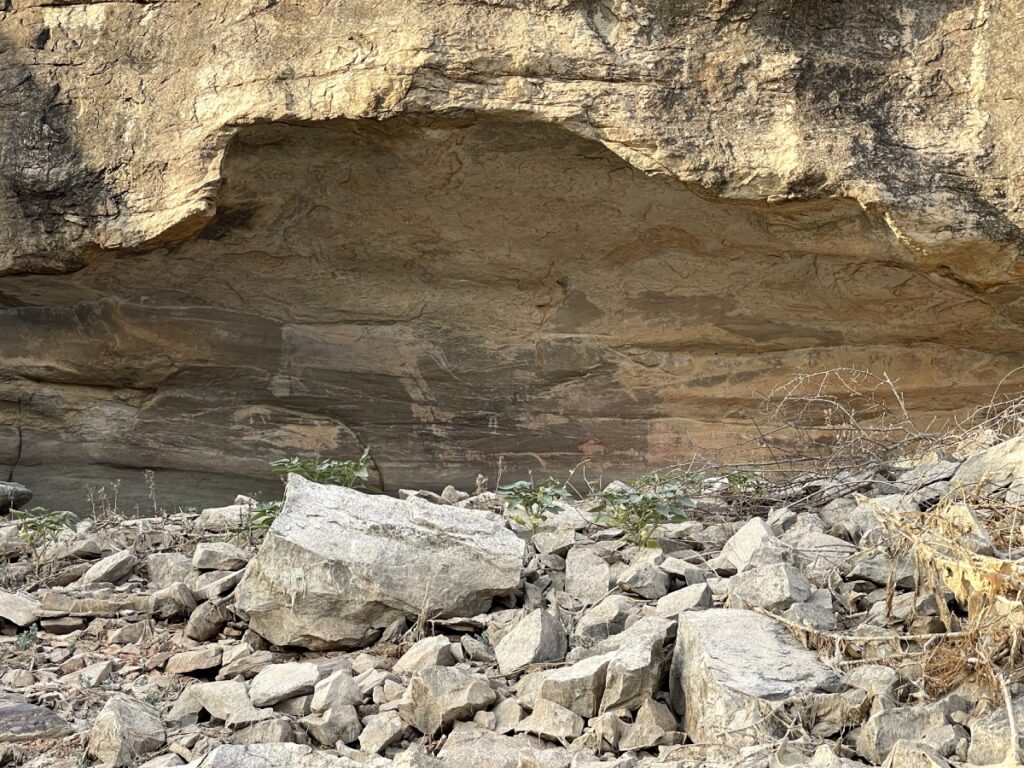
We moved towards the BIG ROCK Point which has Rock paintings, similar to the ones we had seen at Chaturbhuj Nala Rock Shelter. These paintings are pre historic, however, no study has been done yet on these paintings to draw any inference. It can be assumed that as the settlement moved from one place to another, they had left their expression on the walls of their shelter, even if they were transitory, in nature.
Smooth coated INDIAN OTTERS
From a distance, Jagannath could see a family of OTTERS at a nearby rock landing and immediately moved the boat in that direction.
Jagannath was as excited as we were and said “You are very lucky, OTTERS are a rare sight here.” I handed over my phone to Rajesh ji and he quickly captured a video of these cute OTTERS. They are named as Smooth coated INDIAN OTTERS.
As our boat got closer, the OTTERS swiftly dived into the river, one by one, and peeped out of the water at the onlookers for some stretch and then swam away briskly.
GANDHI SAGAR DAM
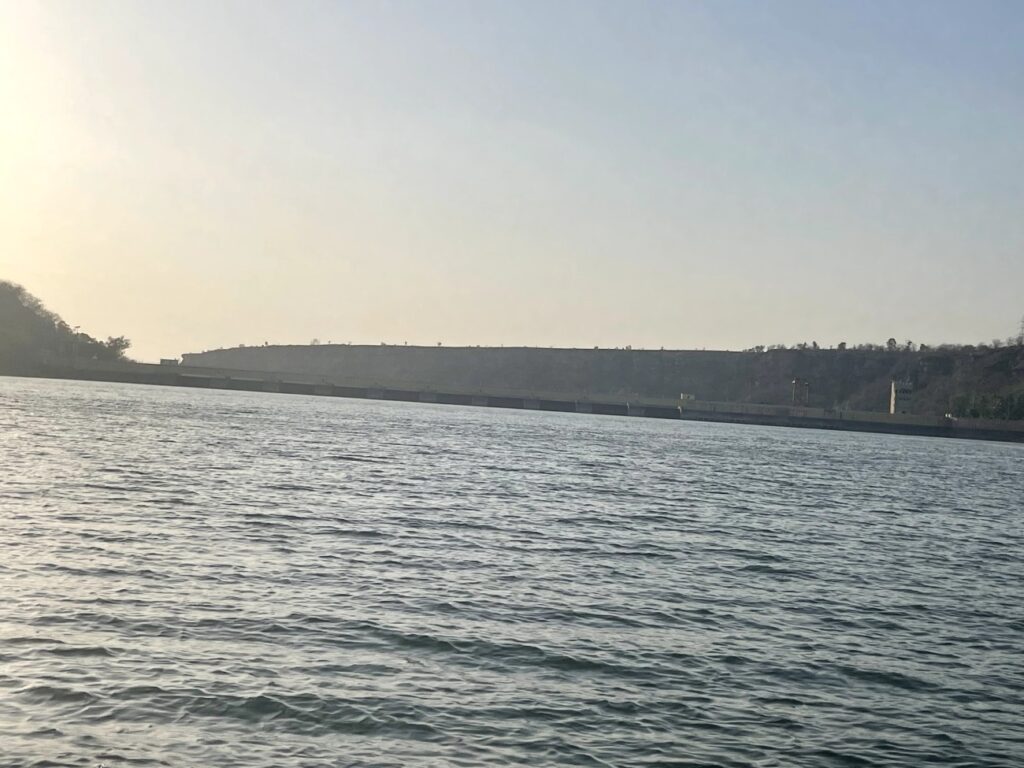
As we paced ahead into the river, we had reached the permissible point of Gandhi Sagar Dam.
By now, we had covered a distance of 8 km from the Boat Club, and the permissible limit is to be 2 km away from the Dam.
An early evening hue on the river, overlooking the Dam was a spectacular sight. The Dam’s massive masonry gravity structure with 10 gated spillway were far from this point and visible, however, the 9 river sluices of the Dam were not so clearly seen.
We paused here for some time to relish that fleeting moment on the Chambal river.
Gradually, the boat turned around from this point.
Jagannath pointed out to the forest reserve, Gandhi Sagar Wildlife Sanctuary which has a good Leopard population.
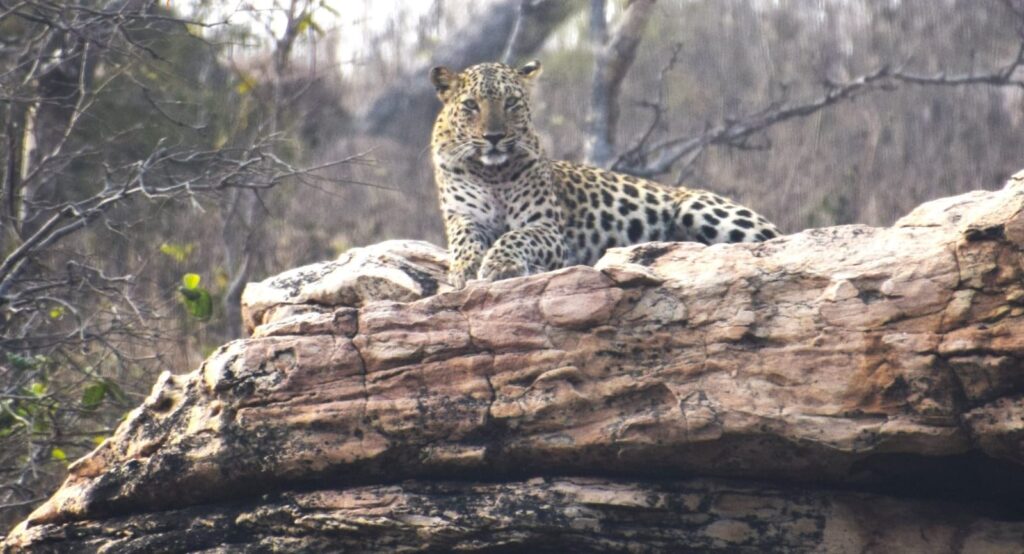
Rajesh ji mentioned that this side of the sanctuary is now a reserved site for reintroduction of the Cheetahs, and expected to be similar to the project of Kuno National Park in Madhya Pradesh.
The limited human settlement have been relocated and the fencing is complete.
The most challenging task that is being undertaken now is the relocation of Leopards to the other side of the forest, given the territorial wars that prevail between Leopards and Cheetahs.
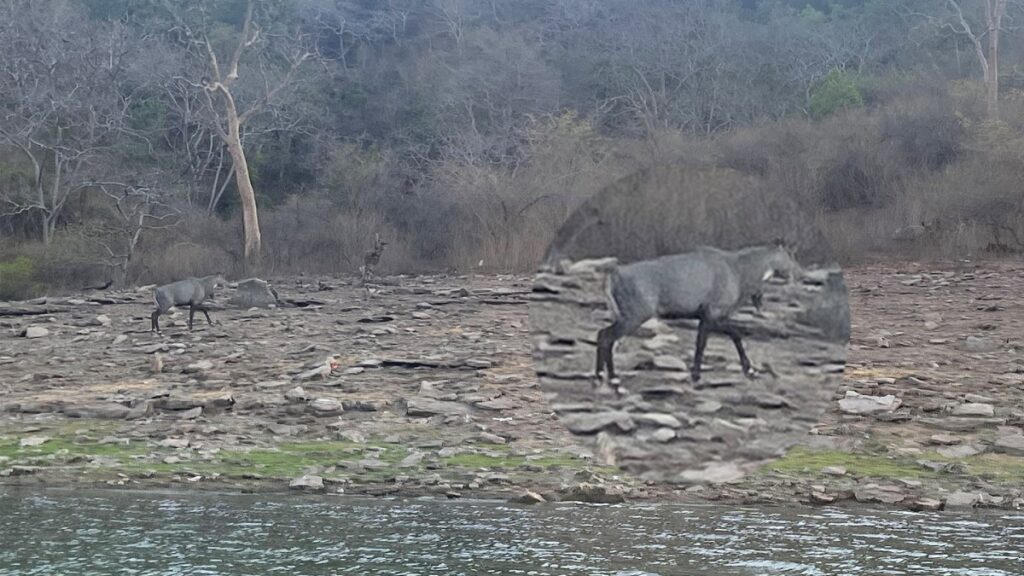
With an extreme summer, water bodies in the forests often dry up and animals visit the river front to drink water before sunset.
We sighted a NILGAI moving away from the river front, briskly into the forest.
CROCODILES IN CHAMBAL RIVER
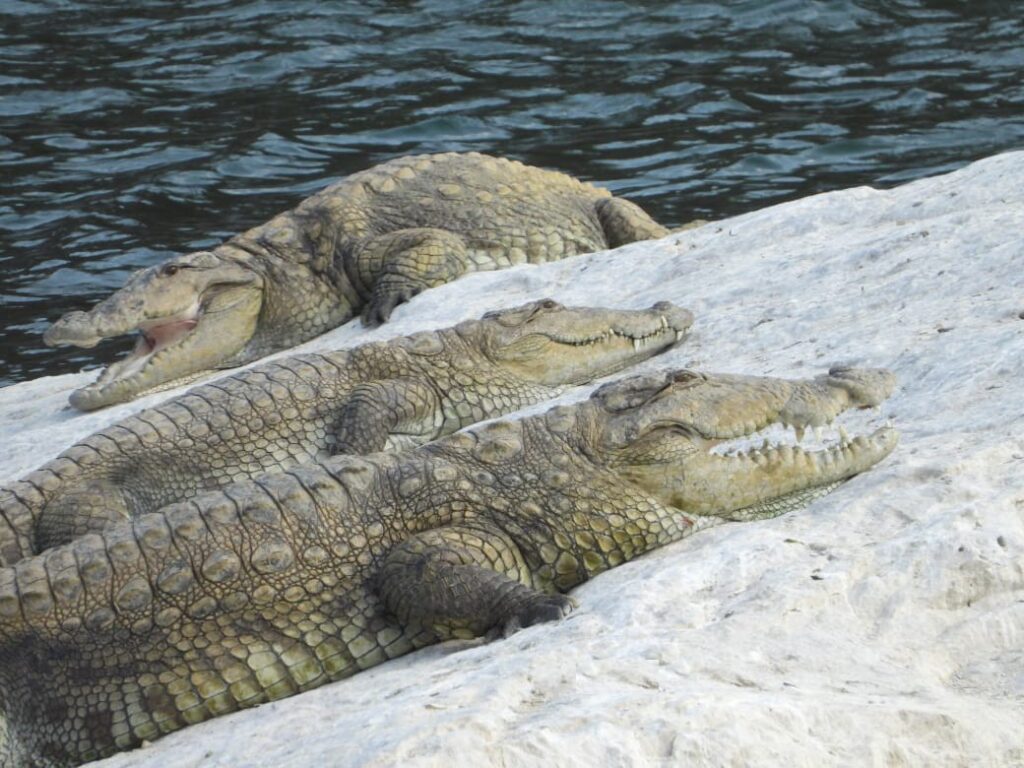
The boat dragged itself to an unusually quiet canal, and Jagannath fearlessly divulged that the density of crocodiles in this spot is reasonably high and they are always visible here.
In winters, it is a sight to see crocodiles climb onto the higher rocks and bask under the sun.
Nearing the edge of one such turn inside the canal, we did see a crocodile, half inside the water. Perhaps, taking a cool dip for now to beat the heat.
BHUTIYA NALA (Ghost Canal)
One of the most amusing tales of this Safari is the BHUTIYA NALA (Ghost Canal).
Many years back, fishermen who laid their nets at night in this canal, heard some strange whispers and sound. They would run away in fear, believing that there were ghosts in the canal. Later, it was found out that some miscreants played mischief on the fishermen. Once they fled, these people would steal away their fishing nets.
BHUTIYA NALA has one of the most exceptional rock formations.
We allowed the boat to laze through this canal and marvelled at the sight for a long while.
We had arrived at the last point of our Safari – THE VULTURE POINT.
The Largest flock of Critically Endangered Vultures are now found in Gandhi Sagar Wild Life Sanctuary.
The State level census of Vultures has revealed that over 800 Vultures of different species have been found in the natural habitat of Vultures in the Gandhi Sagar sanctuary and Bhanpura forests.
VULTURES AT GANDHI SAGAR
Perched on the Rock crags, were hundreds of Vultures, some taking flight flapping their huge wings, some overlooking their nest, some returning back and most of them in a ‘committee’ mode, which means resting.
Never before had I seen such a huge flock of Vultures.
Out of sheer eagerness to share this moment, I made a video call to some of my friends to catch a quick sight of this unbelievable point.
They were dazed to see the large bird taking flight and exclaimed, “JATAYU !”
Way back in school, I do remember reading books that pressed upon the fact that VULTURES ARE NATURE’S CLEANERS as they play a crucial role in maintaining our ecological balance.
DID YOU KNOW ?
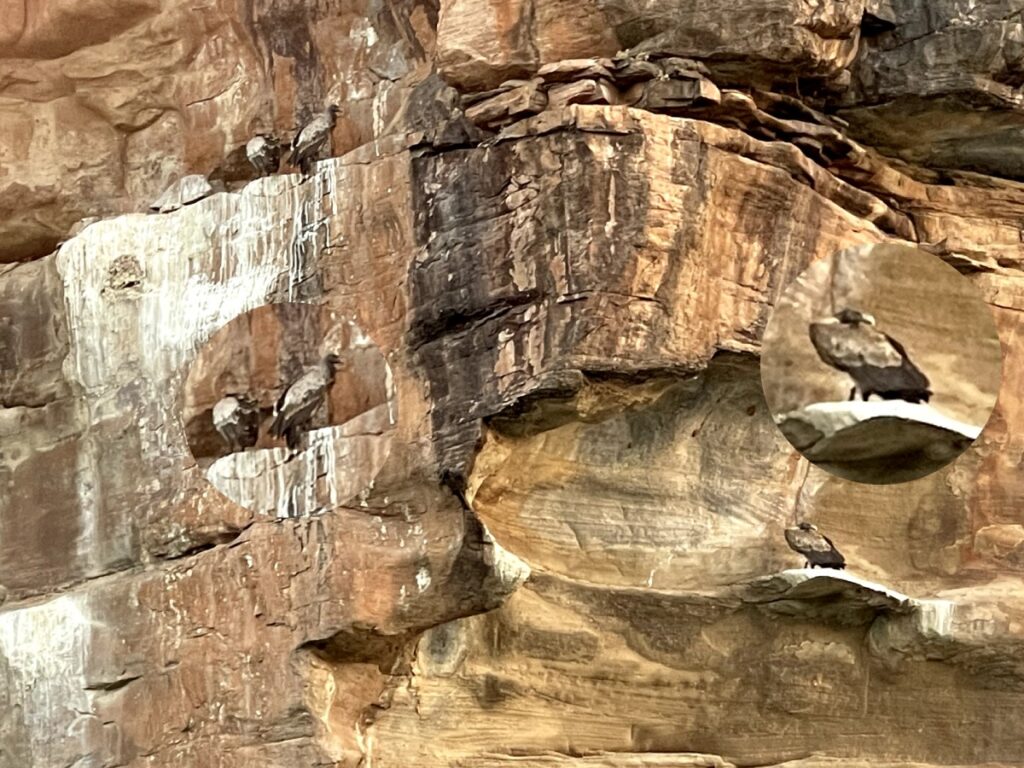
VULTURES are critically endangered species in India under International Union for Conservation of Nature, IUCN Red List of Threatened Species.
In 1990s, the population of Vultures in India was on a rapid decline.
Vultures, then were feeding on the flesh of dead cattle, which contained a veterinary drug, Diclofenac. This drug was given to the cattle to reduce joint pain. Later, this drug which passed through the flesh of dead cattle, turned to be poisonous for the Vultures.
This steady decline in Vulture population posed a serious threat to human life. Animal carcasses were left to rot, which further became breeding grounds for infectious germs, pests and contamination.
In March, 2006, Government of India banned the veterinary drug, Diclofenac and in 2008, a Law was passed declaring the sale of Diclofenac as a imprisonable offense.
This strong move helped in the recovery of Vulture population in India.
We were almost coming to the end of the Safari and I could see myself at peace with the river.
Jagannath looked a bit downbeat suddenly.
He said in a dismayed tone, “It is during this time of the day, LEOPARD sighting is very common on the river front, but, I cannot see them today.”
Intuitively, he paced the boat towards the open area for some distance like the previous evening and took a turn towards the Boat Club.
Suddenly, he screamed, “Look, there is our LEOPARD !”
Both Rajesh ji and Jagannath could see the LEOPARD drinking water on the Modhi Mata Mandir river side.
This was my first experience and I was completely intimidated to see a Big cat so closely. LEOPARDS are known for their quick sprints and incredible speed in the wild.
As the boat drew nearer, there was a hush silence. Within seconds, the LEOPARD tore into the bushes, re appeared for a brief moment and disappeared in the woods.
Jagannath was happy now, like a mission accomplished.
Beaming with pride, he tells us “I have been cruising on this river since August, 2018. Tourists come here with a lot of expectation and I have always strived to give them an experience that they never had before. “
I did make him realise that we have very little control over Nature’s will and ways. As tourists, we have to understand and accept this reality and sail on the cruise with an open mind.
Jagannath heard me attentively and was trying to decode my lines.
Deflecting his attention this time, I asked him about the Fisherfolk of Gandhi Sagar.
FISHES AND FISHERFOLK OF GANDHI SAGAR
The Reservoir created by Gandhi Sagar Dam is the Third Largest in India that harbours a rich and diversified Fish fauna.
A study has recorded that a total of 72 species of FISHES belonging to 9 orders, 20 families and 43 genera are found in this reservoir.
FISHES that have high nutritional value like CATLA, ROHU, MRIGAL, BATA, BAM, PABDA, MAHASEER, KHUDREE, CORSULA, BHALIA, TENGARA, SALEN and SAMAL are caught in large numbers here.
The most prized catch remains to be CATLA, ROHU and MRIGAL that gets an upmarket tag as ‘Gandhi Sagar Fish’ and commands a high premium in fish markets.
STAR CATCH : Large sized CATLA which is about 95cm/3ft in length or ROHU which is 55cm/1.8ft in length.
Gandhi Sagar fishes arrive in plentiful in Kolkata and the fish sellers pompously call out – “Ekhaney ashun Dada, Gandhi Sagorer Catla eshechhe!” – Come here, brother, Gandhi Sagar’s Catla has arrived.
For over 50 years and more, Gandhi Sagar has been the homeland for close to 3000 Bengali families. Majority of them are Fisherfolk who have devoted their lives to the Chambal River.
Jagannath who hails from this community shares, “Fishing is a skill that has been passed down through many generations. The most important Fishing Lesson that we have learnt is Respecting the Environment.”
Jagannath’s niceness is intrinsic, his story telling ability, an art. His love for Chambal River is as deep as the river.
Jagannath Sardar : Mobile +91 9424833929
Follow him on Insta : boat_club_gandhi_sagar
DON’T MISS
They say, Fishing enables you to tangle with the mysterious underwater world and fosters a sense of physical and mental wellbeing.
Yashodharman Boat Club offers two different kinds of ANGLING activity with training – At the Boat Club Jetty and Snakehead (fish) Fishing by boat at identified fishing spots on the river.
I had lost sense of time that evening and it was nearing 7 pm.
Gleefully, I walked up to Captain alongwith Rajesh ji and Jagannath and expressed my gratitude to everyone for making my first ever River Safari so extraordinary and fulfilling in every way.
Captain was delighted to see a gleaming me and offered a much needed cup of coffee. By now, I had connected with the free spirited soul of Captain and was impressed with his firmness about everything around, yet, a profoundly simple being.
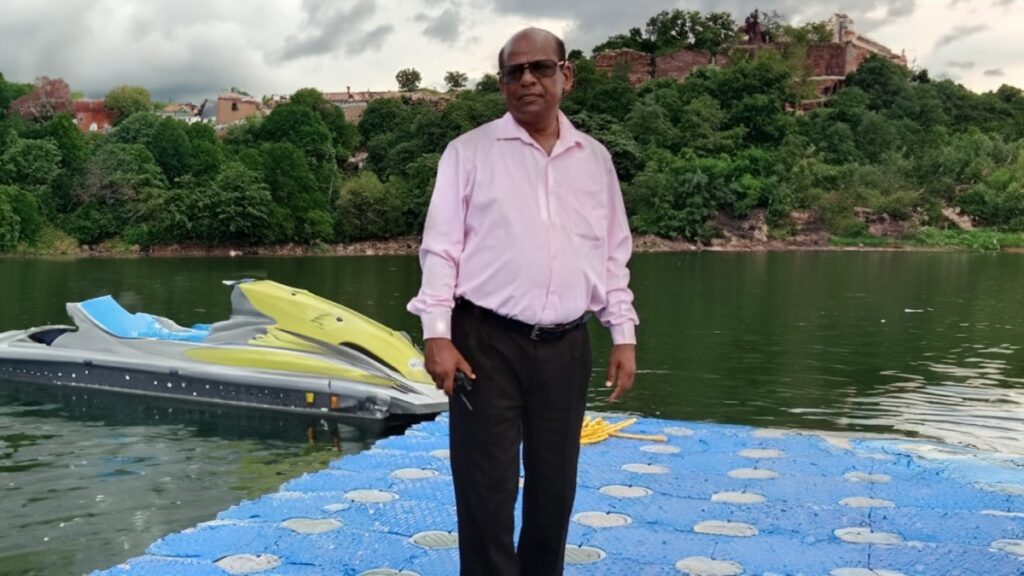
Caption Inder Pal Singh or I P Singh as he is popularly known, is the Technical in charge of Yashodharman Boat Club.
His unassuming and modest persona completely conceals his illustrious service tenure with the Indian Navy.
After 25 years of diligent service in various postings in Vishakhapatnam, Cochin and Mumbai, IP Singh retired from Indian Navy and joined Madhya Pradesh Tourism as Captain.
He has been with Yashodharman Boat Club since inception, 14th February, 2018. Given the wealth of experience that he has accumulated over the years, Captain can comprehend the highs and lows of Nature. He is a Live Wind meter, just like the Anemometer which measures wind speed and wind pressure.
“You must visit Gandhi Sagar in the Rains, this place is so magical. Every monsoon brings a hustle of tourists from all over – Mumbai, Surat, Baroda, Kota, Jhalawar, Indore, Ujjain, Mandsaur and Neemuch.” added Caption graciously.
It was time to leave. Captain and his team were at the gate and smiling.
Captain waved and said, “Come back soon. Come back in another season and you will find this place recast in different colours.”
YASHODHARMAN BOAT CLUB, managed by Madhya Pradesh Tourism
YASHODHARMAN was the most prominent King of Aulikara Dynasty, an ancient dynasty based in the Malwa region, near Mandsaur between the 4th-century CE and 6th-century CE.
It is believed that King Yashodharman had conquered vast territories during his rule.
The Boat Club is named after him.
REJOICE WITH NATURE
For the Adventure loving :
Jet Ski : Single seater, Duration : 5 minutes
Speed Boat : 5 seater, Duration : 5 minutes
Chambal River Safari on Speed boat : Minimum 3 and maximum 5 members, Duration : 45 minutes
Jal Pari : 16 seater, Duration : 15 minutes
Mini Cruise : 30 seater, Duration : 30 minutes
Cruise Boat : 80 seater, Duration : 45 minutes
Malasri Tapu Visit on Speed Boat : 5 seater, Duration: 1 hour
Malasri is an island on Chambal River and offers a stunning view anytime of the day.
There is one operator with every boat.
Timings : 10 am to Sunset
Best time to Visit : All Season
Magical Monsoon with mirthful riot of colours everywhere and spectacular view of waterfalls.
Wonderful Winter for Bird Watching as an added attraction.
Simmering Summer for Best sighting of the Wild on river front.
Best months : July to March
How to Reach :
Motorable road upto the Boat club
By car from Hinglaj Resort, Gandhi Sagar : 3 km
From Kota : 110 km
From Indore : 280 km, Ujjain : 220 km
From Mandsaur : 130 km, Bhanpura : 30 km
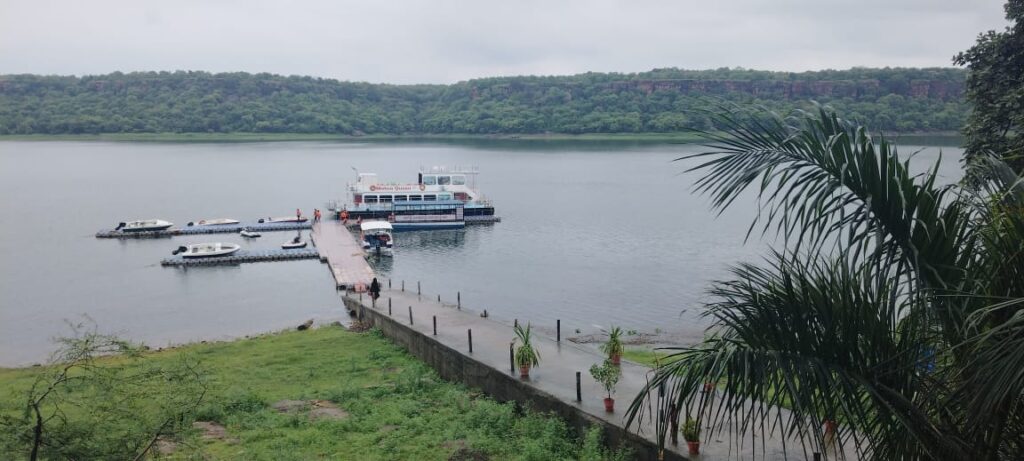
















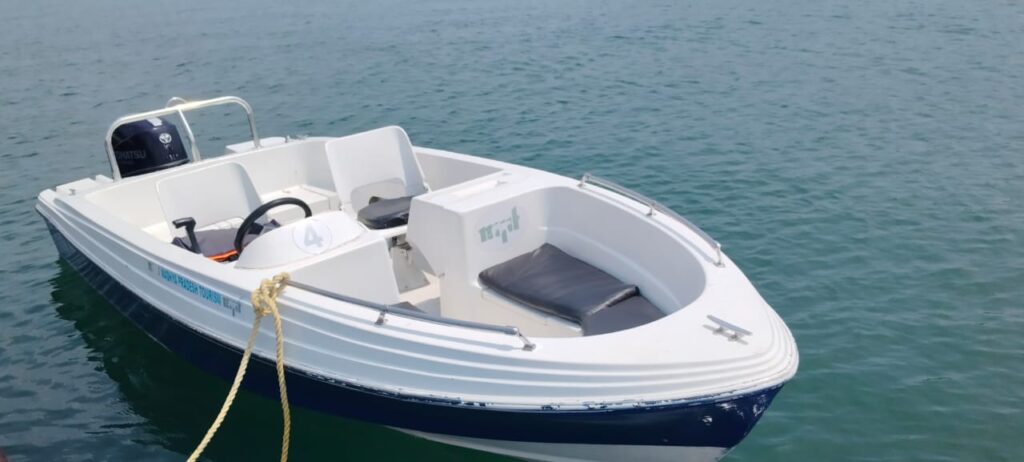
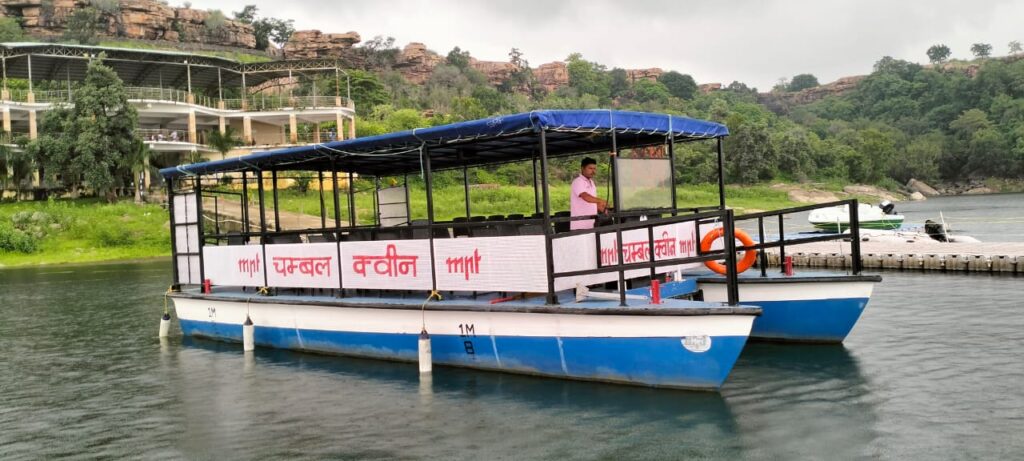
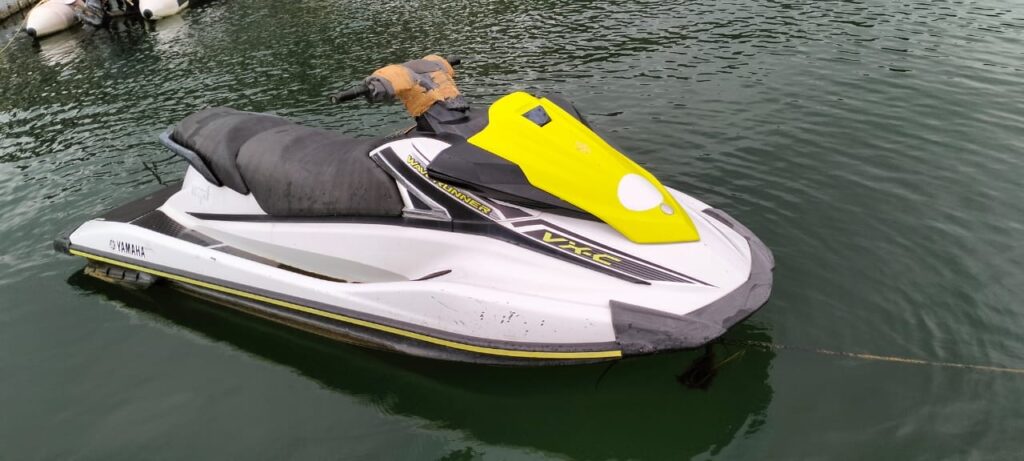
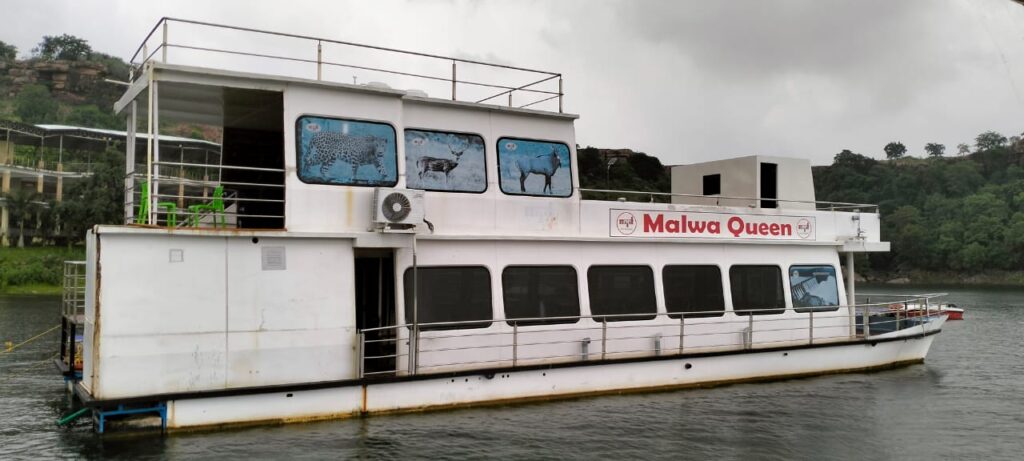
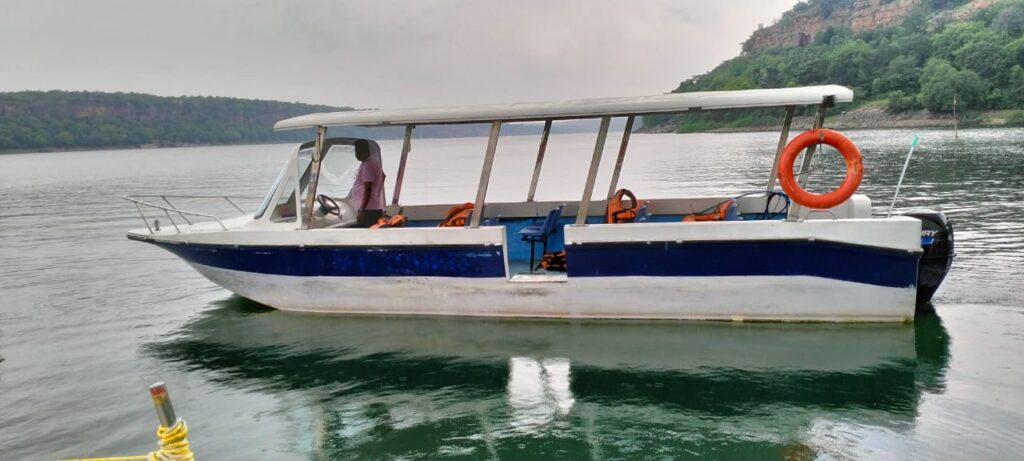
Another good place to plan n visit.
Another good place to plan n visit.
Very interesting read of an area not must know . As always your vivid descriptions of the place to see and experience to be enjoyed makes the place come alive and a desired go to destination .